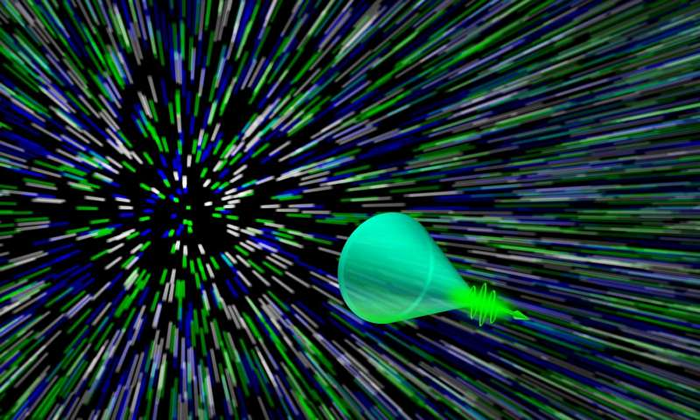Camera captures imagery of optical Mach cone
A team of researchers at Washington University in St. Louis has built a camera apparatus capable of capturing moving imagery of an optical Mach cone. In their paper published in the journal Science Advances, the team describes their image capturing system and other possible applications of the technology.
Most everyone knows that when an object like a jet moves faster than the speed of sound, an acoustic cone is created in its wake that can be heard as a sonic boom. Scientists have theorized that the same type of phenomenon could occur with light, but until now, have not be able to prove it by capturing images of it in action. In this new effort, the researchers have done just that, and have developed an image capturing system capable of taking images of other ultrafast events, as well.
To capture imagery of an optical Mach cone, the researchers approached the problem from both sides—by developing a superfast imaging system and by slowing down light.
The second part was easy; all they had to do was shine a laser through a medium—in this case, a tunnel with dry ice particles that was placed between plates made of aluminum oxide powder and silicone rubber. The light from the laser subsequently traveled faster as it moved through the tunnel compared to the plates, allowing for the formation of an optical Mach cone.
To capture imagery of the cone, the researchers installed three CCD cameras next to the cone-generating apparatus, one of which was a streak camera (it works by converting photons to electrons and bending the path they take). The streak camera was also fitted with patterned filters that allowed for capturing still 2D sequences of images, each of which was assigned a code—after a cone was created and imaged, a 3D image of it was created by combining the 2D pieces in ways reminiscent of a CT scanner. The other two cameras were used to provide more perspective and to improve resolution.
The result of the effort was the first ever video of the cone-shaped wake of light known as a photonic or optical Mach cone. The researchers suggest the same technique could be used to capture imagery of other events such as individual neurons firing—they note it is capable of capturing images at speeds up to 100 billion fps.
More information: Phys.org


Comments are closed, but trackbacks and pingbacks are open.